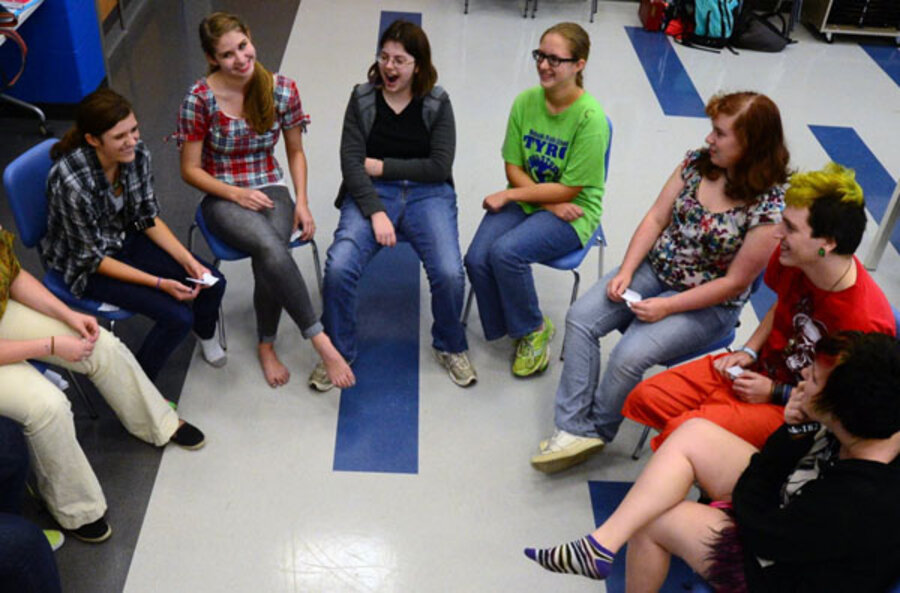Anti-bullying: Gay agenda, or not, the most vulnerable are losing
Loading...
At first glance, a national, annual anti-bullying program that took place earlier this week appeared fairly run-of-the-mill. Organized by the Southern Poverty Law Center, the “Mix it Up at Lunch Day,” encourages students to sit with someone in the cafeteria with whom they would not normally socialize. It’s a way to build tolerance, organizers say, and thus reduce bullying.
While we might be skeptical about the effectiveness of this sort of anti-bullying effort – and we certainly wonder about the social dynamics that go along with that lunch period – it didn’t strike us as all that different from any other anti-bullying program you might see any day, anywhere, in this bully-crazed country.
Except this time there was a controversy.
Controversy, I might add, that sheds light on one of the more interesting tug-of-wars going on beneath the surface of the national anti-bullying movement.
A news story we ran earlier this week looked at how the Mix It Up at Lunch Day became the target of protests by the American Family Association, a conservative Christian group that sees anti-bullying programs promoting “tolerance” as also promoting an “immoral” and “pro-homosexual lifestyle.”
A month before the Oct. 30 event, the AFA began sending alerts to its supporters and encouraging parents to keep their kids home from school that day. It helped organize a telephone campaign against the schools that had already signed up to participate in the Mix It Up at Lunch Day – an effort effective enough that a number of schools asked to be removed from the Southern Poverty Law Center’s list of participants. The Associated Press quoted Bryan Fischer, the AFA’s director of issue analysis, as saying the Law Center was covering up the “real agenda” of the anti-bullying lunch program, and that efforts like this were “particularly insidious.”
It might be tempting for more liberal types to brush aside this battle against Mix it Up at Lunch Day and assume the controversy stems from the lonely actions of one, angry right wing organization.
This, however, would be a mistake. The AFA is neither alone in its concerns, nor in its growing opposition to anti-bullying efforts.
A recent report by the left-leaning People For the American Way detailed how a number of conservative, “family values” organizations, from the Family Research Council to the California-based Protect Kids Foundation, are increasing their opposition to anti-bullying campaigns – especially those that specifically address the victimization of kids who are, or who appear to be, gay.
Many take the stance like that of the California-based Protect Kids Foundation: “Since directly promoting homosexual lifestyles to children is too controversial, LGBT [lesbian, gay, bisexual, transgender] activists hide their agenda behind the ‘safe schools’ and ‘anti-bullying’ curricula.”
Other groups go even further in that stance, notes a report by the People For the American Way: “These groups smeared and demonized advocacy groups that collaborate with teachers and administrators in developing best practices to combat bullying, warning that anti-bullying groups would encourage everything from 'homosexualizing' youth to anti-Christian persecution to pedophilia.”
Wow. Somebody – besides us – actually criticizing the anti-bullying movement. But from a whole different angle.
Which is not to say it’s an angle that’s come out of nowhere. Over recent years, the mainstream anti-bullying movement has taken the stance that everyone is at risk of being bullied. This is, in large part, an institutional approach that is supposed to take blame away from the victim, to get away from the “well what did he do to provoke it” perspective.
There are some good reasons for that. But there’s also a problem: A lot of research shows that this idea of equality in bullying just isn’t valid.
LGBT students – and those perceived to be LGBT – face far, far more bullying than straight students, according to numerous studies. A 2009 report on school climate by the Gay, Lesbian & Straight Education Network found, for instance, that 84.6 percent of LGBT students reported being verbally harassed at school, 40.1 percent reported being physically harassed at school and 18.8 percent reported being physically assaulted at school because of their sexual orientation. These numbers are far higher – double or even triple – what straight students told researchers they experienced.
(A quick side note here: As we’ve discussed in other articles, “harassment” does not equal “bullying,” at least not if you’re going by the standard academic definition of bullying, which includes repeated behavior and a power differential between bully and victim. But these sorts of stats can help describe a school’s general social atmosphere.)
Given the disproportionate impact of bullying on LGBT students, some researchers say that anti-bullying campaigns lose their teeth when they ignore the sexual orientation aspect of student-on-student cruelty. But focusing on that aspect of bullying is a harder sell in many communities – and often less likely to spark the overwhelming, widespread support of parents, politicians, and educators who have been behind the anti-bullying movement.
As the conservative Christian anti-gay groups point out, many anti-bullying curricula address “tolerance” and the need to fight homophobia as part of a more general, and less specific, “safe schools” program. These right-wing groups find this sneaky, and dangerous.
RELATED: Top 5 bullying myths - What you don't know about bullying
Others might find it dangerous for a different reason. Get caught up in the hype of the anti-bully movement – where every nasty comment is considered bullying, and where everyone, from TV anchors to bus monitors to high school students, is an equally likely bullying victim – and, all of a sudden, you lose focus on those kids who are most at risk.








